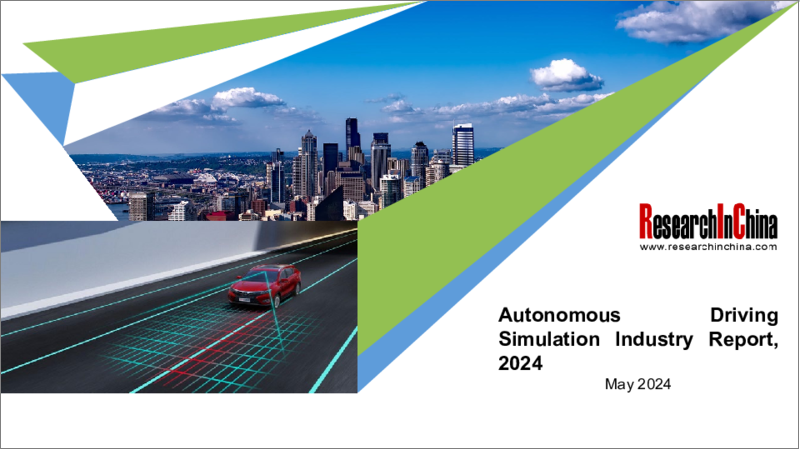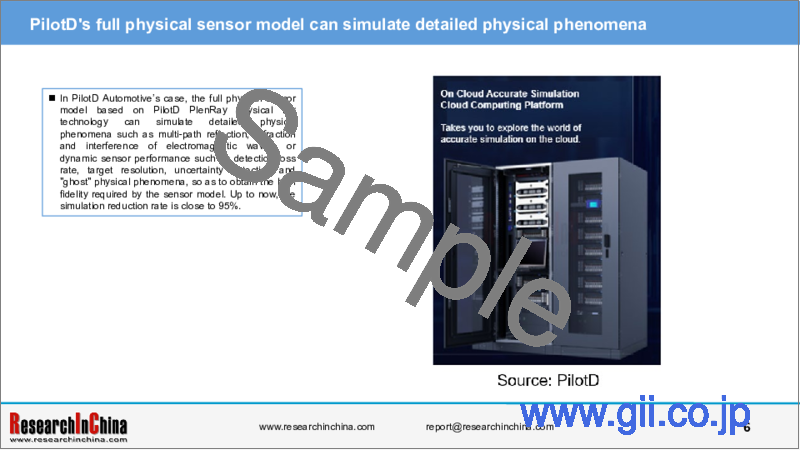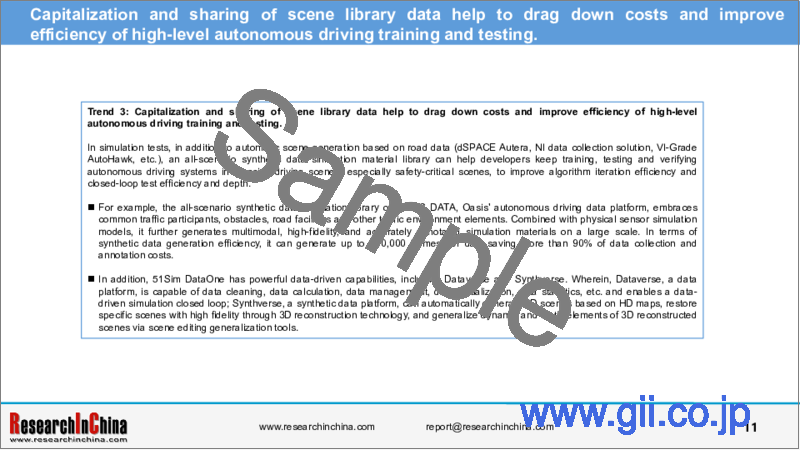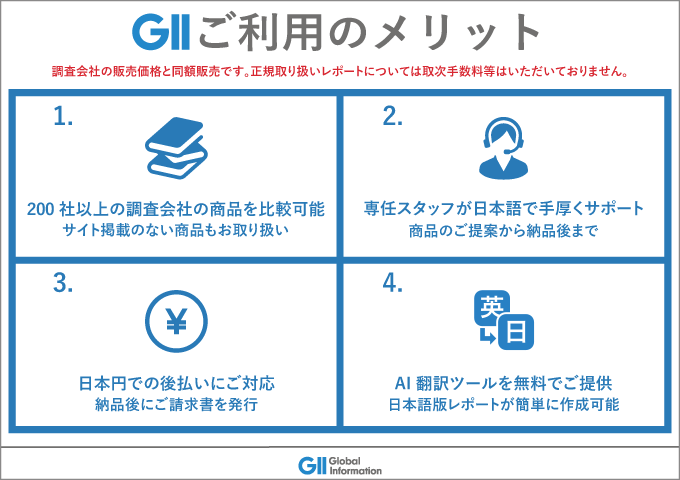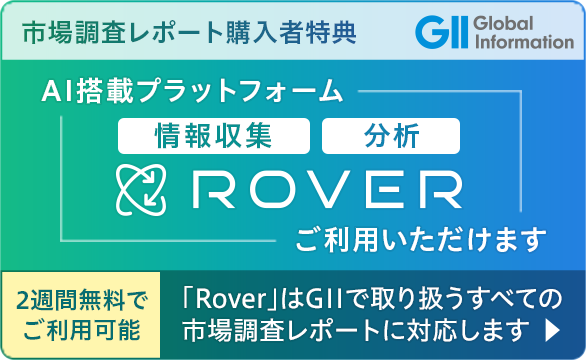|
|
市場調査レポート
商品コード
1482386
中国の自動運転シミュレーション産業(2024年)Autonomous Driving Simulation Industry Report, 2024 |
||||||
| 中国の自動運転シミュレーション産業(2024年) |
|
出版日: 2024年05月10日
発行: ResearchInChina
ページ情報: 英文 480 Pages
納期: 即日から翌営業日
|
- 全表示
- 概要
- 目次
2023年11月17日、工業情報化部とその他の三省は「インテリジェントコネクテッドカーの試乗と路上通行に関する通知」を発表しました。現在までに、BYD、BMW、IM、Mercedes-Benz、Deepal、Avatr、ARCFOX、AITO、Jiyue、GAC Aionなど多くのOEMが高速道路または都市部のL3自動運転試験ライセンスを取得しています。現在、都市型NOAに代表される高レベルのインテリジェントドライビング機能の利用が加速しており、L3以上の自動運転システムは、都市部における無数のエッジ/ロングテールケースに対応できる安全性と堅牢性を備えていなければなりません。
L3インテリジェントドライビングシステムの実用化には10億km超の試験走行が必要であり、実際の走行テストはコストと時間がかかり、ユースケースのカバー率も低いです。しかし、シミュレーションテストであれば、この問題を短時間かつ低コストで解決できます。Xpengの場合、車の所有者から毎日提供される路上データに加え、Xpengはインテリジェントドライビングシステムが学習し理解するためのシミュレーションを組み合わせた仮想空間での極端なシナリオの構築に取り組んでいます。2023年末までに、Xpengのシミュレーション走行距離は1億2,200万kmに達しました。
インテリジェントドライビングの「3本柱」試験方式では、シミュレーションテストにおいて、仮想環境を通じてさまざまな交通シーン、道路状況、天候照度、異常事態をシミュレートし、さまざまな状況における自動運転システムの機能、反応、判断能力を評価します。
上図では、自動運転シミュレーションプラットフォームは、交通シーンシミュレーション(静的シーン復元と動的シーンシミュレーション)、環境認識センサーシミュレーション(カメラ、LiDAR、レーダー、GPS/IMUなどのセンサーのモデリングとシミュレーション)、車両力学シミュレーションなどをサポートし、知覚から制御までのシミュレーションテストを検証する必要があります。試験対象に応じて、自動運転シミュレーションプラットフォームは、MIL(Model in the Loop)、SIL(Software in the Loop)、HIL(Hardware in the Loop)、DIL(Driver in the Loop)、VIL(Vehicle in the Loop)などのインザループテストを可能にします。現在、シミュレーション試験企業の能力はさまざまです。
動向1:自動運転シミュレーション試験は、高忠実度・高削減の精密シミュレーション段階に入っています。
「知覚 - 予測 - 判断 - 計画 - 制御」の全体の結びつきにおいて、知覚は、交通の流れ、道路状況、天候、照度、異常など、車両の外部環境情報を収集するあらゆる種類のセンサーに対応します。主にカメラシミュレーション、LiDARシミュレーション、レーダーシミュレーション、測位シミュレーション(GPS、IMU)が含まれます。
現在、多くの企業がきめ細かいシミュレーションエンジニアリングの実践に取り組んでおり、例えば、実際の道路環境、動的な交通シーン、車両および歩行者の挙動を忠実にシミュレーションし、詳細な物理現象や動的センサー性能を正確に復元することで、自動運転システムの性能を迅速に検証し、包括的なテストと検証のレポートを提供しています。
PilotD Automotiveの場合、PilotD PlenRay物理光線技術に基づく完全な物理センサーモデルは、電磁波のマルチパス反射、屈折、干渉などの詳細な物理現象や、検出損失率、目標分解能、不確実性検出、「ゴースト」物理現象などの動的センサー性能をシミュレートすることができ、センサーモデルが要求する高い忠実度を得ることができます。現在までのシミュレーション削減率は95%に近いです。
当レポートでは、中国の自動運転シミュレーション産業について調査分析し、シミュレーション技術、国内外のソリューションプロバイダー、シミュレーションテストの動向などの情報を提供しています。
目次
第1章 自動運転シミュレーションの概要
- 自動運転の研究開発におけるシミュレーション試験の重要性
- 自動運転シミュレーション技術の分類(1)
- 自動運転シミュレーション技術の分類(2)
- 自動運転シミュレーションテストデータプラットフォームソリューションの概要(1)
- 自動運転シミュレーションテストデータプラットフォームソリューションの概要(2)
- 自動運転シミュレーションソフトウェアの概要
- 国内の自動運転シミュレーションの企業とOEMの比較(1)
- 国内の自動運転シミュレーションの企業とOEMの比較(2)
- 国外の自動運転シミュレーションの企業とOEMの比較
- 自動運転シミュレーションの産業チェーン
第2章 自動運転シミュレーションテストシーンライブラリ
- 自動運転シミュレーションの国際標準化機構:ASAM
- 自動運転シミュレーション組織:ISO・欧州のペガサスプロジェクト
- 中国のASAM規格:C-ASAMワーキンググループ
- 自動運転シーンシミュレーションの標準と規制の現状
- 自動運転シミュレーションテストシーンライブラリとその機能
- シミュレーションの評価
第3章 シミュレーション技術
- 最初の国家デジタルツイン標準
- デジタルツインエコシステム構築の実践
- デジタルツインの典型的な応用シナリオ
- デジタルツインの応用事例1:自動車製造
- デジタルツインの応用事例2:電動ドライブ開発 - OEM
- デジタルツインの応用事例3:コックピットシステムのクラウド化 - OEM
- デジタルツインの応用事例4:スマート高速道路 - シミュレーションソリューションプロバイダー
- AIとシミュレーション
第4章 国内のシミュレーションプラットフォームソリューションプロバイダー
- PanoSim
- PilotD
- Vehinfo
- Keymotek
- Beijing Oriental Jicheng
- SaimoAI
- 51WORLD
- IAE
- SYNKROTRON
- RisenLighten
- Dotrust Technologies
- BeCreator
- Tsing Standard
- RACO
- Jingwei Hirain
- EASY SIMULATION SMART
- ALINX
- Kunyi Electronics
- Tencent
- Baidu
- Huawei
第5章 国外のシミュレーションプラットフォームソリューションプロバイダー
- Foretellix
- dSPACE
- NI
- Vector
- MathWorks
- NVIDIA
- IPG Automotive
- Ansys (affiliated to Synopsys)
- VI-Grade
- Ansible Motion
- Applied Intuition
- Anyverse
第6章 自動運転シミュレーションテストの動向
Autonomous Driving Simulation Research: Three Trends of Simulation Favoring the Implementation of High-level Intelligent Driving.
On November 17, 2023, the Ministry of Industry and Information Technology and other three ministries issued the Notice on Piloting Access and On-road Passage of Intelligent Connected Vehicles. Up to now, many OEMs including BYD, BMW, IM, Mercedes-Benz, Deepal, Avatr, ARCFOX, AITO, Jiyue and GAC Aion have obtained highway or urban L3 autonomous driving test licenses. At present, the application of high-level intelligent driving functions represented by urban NOA is being accelerated, and L3 and above autonomous driving systems should be safe and robust enough to deal with countless edge/long tail cases in urban areas.
The commercialization of L3 intelligent driving systems needs more than one billion kilometers of test mileage, and actual road tests are costly and time-consuming, with low use case coverage. However, simulation tests can quickly solve this problem in a short time and at low cost. In Xpeng's case, in addition to the roadside data provided by car owners every day, Xpeng is working to build extreme scenarios in virtual space combining simulation for the intelligent driving system to learn and understand. By the end of 2023, the simulation mileage of Xpeng had reached 122 million kilometers.
In the "three-pillar" test approach for intelligent driving, in simulation tests, different traffic scenes, road conditions, weather illumination and abnormalities are simulated through the virtual environment to evaluate the functions, response and decision capabilities of the autonomous driving systems in various circumstances.
In the above figure, the autonomous driving simulation platform should support traffic scene simulation (static scene restoration and dynamic scene simulation), environment-aware sensor simulation (modeling and simulation of sensors such as camera, LiDAR, radar and GPS/IMU), vehicle dynamics simulation, etc., so as to verify simulation tests ranging from perception to control. According to tested objects, the autonomous driving simulation platform enables in-the-loop tests such as: model in the loop (MIL), software in the loop (SIL), hardware in the loop (HIL), driver in the loop (DIL) and vehicle in the loop (VIL). At present, simulation test companies vary in capabilities, as shown in the table below.
Trend 1: Autonomous driving simulation tests have entered the precise simulation stage with high fidelity and high reduction.
In the whole link of "perception-prediction-decision-planning-control", perception corresponds to all kinds of sensors which collect the external environment information of the vehicle, such as traffic flow, road conditions, weather, illumination and abnormalities. It mainly involves camera simulation, LiDAR simulation, radar simulation, and positioning simulation (GPS, IMU).
At present, many companies are working on fine-grained simulation engineering practices, for example, high fidelity simulation of real road environment, dynamic traffic scene and vehicle/pedestrian behavior, and accurate restoration of detailed physical phenomena and dynamic sensor performance, so as to quickly verify the performance of autonomous driving systems and provide comprehensive test and verification reports.
In PilotD Automotive's case, the full physical sensor model based on PilotD PlenRay physical ray technology can simulate detailed physical phenomena such as multi-path reflection, refraction and interference of electromagnetic waves, or dynamic sensor performance such as detection loss rate, target resolution, uncertainty detection and "ghost" physical phenomena, so as to obtain the high fidelity required by the sensor model. Up to now, the simulation reduction rate is close to 95%.
NVIDIA DRIVE Sim(TM) supported by NVIDIA Omniverse is an end-to-end simulation platform, physically based multi-sensor simulation with high fidelity. It can generate numerous real-world digital twin scenes. At present, the LiDAR models of HESAI and RoboSense have been integrated into NVIDIA DRIVE Sim to simulate the performance of LiDAR in various aspects such as beam control, user-defined scanning modes and resolution, and generate synthetic data sets. Users such as OEMs or autonomous driving solution providers can directly call the LiDAR models for R&D or testing through DRIVE Sim.
Similar to NVIDIA, the 3D scene and high-precision physical sensor simulation of dSPACE AURELION generates highly realistic raw data for radar, LiDAR and cameras in real time. AURELION optimizes the impact of materials on radar echoes and multi-path ray tracing technology to ensure real-world-like measurement effects (e.g. ghost spot effects). For radar, dSPACE offers DARTS, that is, over-the-air simulation of radar echoes in real time.
In the vehicle's perception of environmental information, it is easy to ignore the simulation of the interaction between vehicles and pedestrians. For example, the Qianxing simulation platform of RisenLighten has added rich and realistic pedestrian models to support the functions of self-defining the micro-trajectory of pedestrians and generating pedestrians in batches. When editing scenes, users can simulate the crowded and sparse pedestrian distribution in reality as needed, and can also build complex long-tail scenes such as pedestrians walking randomly, sudden pedestrians in front, courtesy to people and cars, and dispute on right of way to test the comprehensive performance of the autonomous driving system. The platform also provides different pedestrian behavior style models, covering scenarios such as human-vehicle interaction, crossing the road and crossing the intersection obliquely, to simulate an intelligent pedestrian traffic flow. In addition, with the diverse driver behaviors, the platform models three driving styles of drivers (conservative drivers, conventional drivers and radical drivers), and refines each parameter through a certain probability distribution, so that the driving behaviors of vehicles in the environment are diversified and randomized.
In addition, multi-sensor concurrent simulation tests greatly improve the R&D and testing efficiency of perception algorithms. In terms of engineering practice, in May 2023 51Sim and VCARSYSTEM cooperated to successfully fulfill the closed loop of domain controllers from SIL to HIL in China's autonomous driving tests, and realized the thorough localization of domain controller in-the-loop simulation tests. In this domestic domain controller in-the-loop solution based on Journey 5, the intelligent driving data reinjection system independently developed by VCARSYSTEM supports simultaneous injection of sensor data from multiple high-definition cameras, LiDAR, radar, ultrasonic radar, GNSS&IMU and so on, and easily reproduces specific scenes and environments via 51Sim-One, an autonomous driving simulation test platform, thereby greatly improving the R&D and testing efficiency of perception algorithms.
Trend 2: Automatic generation and scene generalization are essential.
At present, how to build a corner case scene is a big challenge for the industry. It is the significance of simulation tests to reproduce scenes such as high-risk working conditions, extreme weather conditions, complex traffic environment and edge events, which are difficult to cover in actual road tests. Especially for large-scale tests of safety-critical scenes, automated simulation technology based on AI technology is needed to cover more scenarios.
Coverage-based quality is a more detailed and comprehensive autonomous driving safety test method. It focuses on the quality of test coverage, that is, whether the system has experienced various possible situations and scenarios. By defining a range of test cases and test scenes, this method can ensure that autonomous driving systems can be tested in various road conditions, traffic conditions and abnormalities. The quality of coverage can involve changes in road conditions, traffic behaviors, special weather conditions, emergencies and more.
Moveover, AI technology and large language models are gradually integrated into simulation tests, playing an increasingly important role in automatic scene generation, automatic annotation, accelerating the construction of scene libraries, reducing the cost of simulation tests, lowering the threshold of simulation test technology and shortening the vehicle development cycle.
In the case of natural language interaction, 51WORLD's AIGC-Scenario Copilot supports fully natural language interaction. Without tedious manual editing and code, it only needs scene descriptions, for example, "add an action, first change the lane to the right, and then slow down to 0". By using an AI large language model, an autonomous driving simulation test scene conforming to the OpenSCENARIO standard can be generated, and an unknown dangerous scene can also be generated to expand the boundary of the simulation test.
In addition, Huawei Pangu Models feature the following in generation of autonomous driving scenes:
Autonomous driving scene understanding replaces manual annotation and classification, and 10,000 video clips are processed in minutes.
Autonomous driving scene generation, vehicle type change, lane change, scene combination rendering and other applications are realized through NeRF technology.
Autonomous driving pre-annotation replaces manual annotation, and supports 2D, 3D and 4D automatic annotation, with an accuracy rate of over 90%.
Autonomous driving multimodal retrieval supports multi-dimensional retrieval capabilities such as searching for pictures by text and searching for pictures by pictures, and realizes minute-level retrieval of millions of pictures.
In addition to simulation platforms and scene library generalization capabilities mentioned above, simulation evaluation systems for autonomous driving testing are also essential in autonomous driving technology commercialization. Simulation evaluation refers to the evaluation and optimization of all aspects of an autonomous driving system by means of simulation testing to ensure its safe, reliable and efficient operation on actual roads. Simulation evaluation mainly includes autonomous driving system evaluation and simulation test system evaluation, of which simulation test system evaluation includes the evaluation of scenario coverage, scene realness, scene effectiveness and simulation efficiency.
Trend 3: Capitalization and sharing of scene library data help to drag down costs and improve efficiency of high-level autonomous driving training and testing.
In simulation tests, in addition to automatic scene generation based on road data (dSPACE Autera, NI data collection solution, VI-Grade AutoHawk, etc.), an all-scenario synthetic data simulation material library can help developers keep training, testing and verifying autonomous driving systems in massive driving scenes, especially safety-critical scenes, to improve algorithm iteration efficiency and closed-loop test efficiency and depth.
For example, the all-scenario synthetic data simulation library of OASIS DATA, Oasis' autonomous driving data platform, embraces common traffic participants, obstacles, road facilities and other traffic environment elements. Combined with physical sensor simulation models, it further generates multimodal, high-fidelity, and accurately annotated simulation materials on a large scale. In terms of synthetic data generation efficiency, it can generate up to 100,000 frames per day, saving more than 90% of data collection and annotation costs.
In addition, 51Sim DataOne has powerful data-driven capabilities, including Dataverse and Synthverse. Wherein, Dataverse, a data platform, is capable of data cleaning, data calculation, data management, data visualization, data statistics, etc. and enables a data-driven simulation closed loop; Synthverse, a synthetic data platform, can automatically generate 3D scenes based on HD maps, restore specific scenes with high fidelity through 3D reconstruction technology, and generalize dynamic and static elements of 3D reconstructed scenes via scene editing generalization tools.
In November 2023, 51Sim, together with Volcengine, TZTEK and MXNAVI, the ecosystem partners of Horizon Robotics, launched the industry's first full-chain data-driven closed-loop ecosystem solution to accelerate the mass production and application of autonomous vehicles. This solution provides chips, domain controllers, data acquisition, data processing, algorithm training, refeed testing, and simulation software and hardware integrated testing, aiming to solve common problems in the intelligent driving industry such as low data utilization and difficult data-driven closed loop construction, and promote the mass production and application of high-level autonomous driving. 51Sim provides a full set of virtual simulation test capabilities for the data-driven closed-loop ecosystem.
Amid surging demand for training and test data of autonomous driving systems, it is difficult to collect diverse and high-quality long-tail scenes on a large scale, and filter the required scenes. In view of this, some simulation solution providers such as SYNKROTRON, IAE and 51Sim have begun to work on the data assetization of simulation scene libraries (including standard regulatory scenes, accident scenes, natural driving scenes, dangerous/extreme scenes, and reconstruction scenes). They have also made a positive response to the "Three-Year Action Plan for 'Data Elements x" (2024-2026), and assisted the intelligent connection industry with assetization of data, which have been traded on Shenzhen Data Exchange, Shanghai Data Exchange, Suzhou Big Data Exchange, and Northern Big Data Trading Center.
In the aspect of simulation data sharing, it is necessary to handle vehicle-cloud cooperation. For example, in the conventional stand-alone R&D environment, the data silo within a team has been a serious problem. How to achieve an efficient working mode among XIL test engineers, tool chain R&D engineers, algorithm training engineers and algorithm test engineers has been tackled. For example, in April 2024, 51SimOne officially released the cooperative version of the "cloud+terminal" integrated product. Through centralized storage and integrated design, it seamlessly connects the client and the cloud, and supports multi-person cooperation, so that data is fully shared among a team. The client supports local integration and debugging of R&D tasks, and the cloud bolsters phased large-scale automated testing in algorithm development, so that a platform can meet various needs and greatly accelerate the iteration and optimization of autonomous driving algorithms.
Table of Contents
1 Overview of Autonomous Driving Simulation
- 1.1 Significance of Simulation Testing to Autonomous Driving R&D
- 1.1.1 Cases of Simulation Testing in Cost Reduction
- 1.2 Classification of Autonomous Driving Simulation Technology (1)
- 1.2.1 Traffic Scene Simulation
- 1.2.2 Sensor Simulation
- 1.2.3 Vehicle Dynamics Simulation
- 1.3 Classification of Autonomous Driving Simulation Technology (2)
- 1.3.1 MIL and Solution Comparison
- 1.3.2 SIL and Solution Comparison
- 1.3.3 HIL and Solution Comparison
- 1.3.4 VIL and Solution Comparison
- 1.3.5 DIL and Solution Comparison
- 1.4 Summary of Autonomous Driving Simulation Test Data Platform Solutions (1)
- 1.5 Summary of Autonomous Driving Simulation Test Data Platform Solutions (2)
- 1.6 Summary of Autonomous Driving Simulation Software
- 1.7 Comparison among Domestic Autonomous Driving Simulation Companies and OEMs (1)
- 1.8 Comparison among Domestic Autonomous Driving Simulation Companies and OEMs (2)
- 1.9 Comparison among Foreign Autonomous Driving Simulation Companies and OEMs
- 1.10 Autonomous Driving Simulation Industry Chain
2 Autonomous Driving Simulation Test Scene Libraries
- 2.1 International Organization for Standardization of Autonomous Driving Simulation: ASAM
- 2.2 autonomous driving Simulation Organization: ISO & Europe Pegasus Project
- 2.3 Chinese ASAM Standards: C-ASAM Working Group
- 2.4 Status Quo of Autonomous Driving Scene Simulation Standards and Regulations
- 2.5 Autonomous Driving Simulation Test Scene Libraries and Their Features
- 2.5.1 Classification of Scene Libraries
- 2.5.2 Overview of Scene Abstraction Classification
- 2.5.3 Scene Elements and Automatic Generation
- 2.5.4 Data Sources of Scene Libraries
- 2.5.5 ASAM OpenX Series Standard System
- 2.5.6 Construction Process of Scene Libraries
- 2.6 Simulation Assessment
3 Simulation Technology
- 3.1 The first National Digital Twin Standard
- 3.2 Practice of Digital Twin Ecosystem Construction
- 3.3 Typical Application Scenarios of Digital Twin
- 3.4 Digital Twin Application Case 1: Automobile Manufacturing
- 3.4.1 Digital Twin Technology Empowerment (1): OEMs
- 3.4.2 Digital Twin Technology Empowerment (2): OEMs
- 3.4.3 Digital Twin Technology Empowerment (3): OEMs
- 3.4.4 Digital Twin Technology Empowerment (4): OEMs
- 3.5 Digital Twin Application Case 2: Electric Drive Development - OEMs
- 3.6 Digital Twin Application Case 3: Cloudization of Cockpit Systems - OEMs
- 3.7 Digital Twin Application Case 4: Smart Expressways - XXX Simulation Solution Providers
- 3.8 AI and Simulation
- 3.8.1 Application of AI in Simulation Platforms
- 3.8.2 AI Simulation Application Cases: OEMs
- 3.8.3 What Changes Have AIGC and Foundation Models Brought to AD Simulation?
- 3.8.4 Simulation Cases Based on Foundation Model Training: OEMs
- 3.8.5 Cases of AIGC Automatically Generating Simulation Test Scenes: Simulation Solution Providers
4 Domestic Simulation Platform Solution Providers
- 4.1 PanoSim
- 4.1.1 Profile
- 4.1.2 Development Events
- 4.1.3 Five Core Products and Features
- 4.1.4 PanoSim Simulation Software Toolchain
- 4.1.5 Application of PanoSim "Vehicle-road-cloud" Integration
- 4.1.6 PanoDrive Intelligent Vehicle Driving Simulator
- 4.1.7 PanoTwin Digital Twin Simulation Platform
- 4.1.8 PanoPilot Simulation Test Bench
- 4.1.9 PanoHIL Chassis HIL Bench
- 4.1.10 Ecosystem Partners (1): OEMs
- 4.1.11 Ecosystem Partners (2): Suppliers & Research and Testing Institutions
- 4.1.12 Ecosystem Partners (3): Universities & Others
- 4.1.13 Cooperation Cases with Ecosystem Partners
- 4.1.14 Summary of Simulation Products
- 4.2 PilotD
- 4.2.1 Profile
- 4.2.2 Development History
- 4.2.3 Core Technology
- 4.2.4 Product System
- 4.2.5 PDGaiA Autonomous Driving Accurate In-the-Loop Simulation Testing Platform
- 4.2.6 PDRHea(R) Recursive Layered Scene Generator
- 4.2.7 DIL Solutions
- 4.2.8 On Cloud Accurate Simulation Cloud Computing Platform
- 4.2.9 Medusa Vehicle High Confidence Simulation Platform
- 4.2.10 Hercules HIL with High Cost Performance
- 4.2.11 Model Library Sharing Platform: Weighter Matrix
- 4.2.12 Partners
- 4.2.13 Summary of Simulation Products
- 4.3 Vehinfo
- 4.3.1 Profile
- 4.3.2 Development History
- 4.3.3 Main Business
- 4.3.4 LABCAR HIL
- 4.3.5 Application Cases of LABCAR HIL
- 4.3.6 YIES Intelligent Test Data Fusion Cloud Platform
- 4.3.7 Major Customers and Partners
- 4.3.8 Summary of Simulation Products
- 4.4 Keymotek
- 4.4.1 Profile
- 4.4.2 Main Business
- 4.4.3 Main Products
- 4.4.4 Autonomous Driving HIL Solutions
- 4.4.4 Autonomous Driving HIL Solutions: Sensor Simulation
- 4.4.5 Autonomous Driving aiSim Simulation SIL Solutions
- 4.4.6 Technical Architecture of aiSim
- 4.4.6 Main Specifications of aiSim
- 4.4.6 GUI of aiSim
- 4.4.6 Product Advantages of aiSim
- 4.4.7 aiSim5
- 4.4.8 Functions of aiSim5
- 4.4.9 Data Collection and Recording Solutions
- 4.4.10 HEEX Intelligent Data Management Platform
- 4.4.11 Customers
- 4.4.12 Summary of Simulation Products
- 4.5 Beijing Oriental Jicheng
- 4.5.1 Profile
- 4.5.2 New Energy Vehicle Testing Solutions
- 4.5.3 Intelligent Cockpits and Connectivity Testing Solutions
- 4.5.4 VIL Solutions
- 4.5.5 ADAS HIL
- 4.5.6 VCU HIL
- 4.5.7 BMS HIL
- 4.5.8 MCU HIL
- 4.5.9 Joint Debugging and Testing System of "Electric Drive, Batteries And Electric Control"
- 4.5.10 C-V2X Application Scenario HIL Simulation Test System
- 4.5.11 Intelligent Chassis HIL Test Solutions
- 4.5.12 Driver Simulator Series
- 4.5.13 DeskSim
- 4.5.14 MDS
- 4.5.15 CDS
- 4.5.16 Seat Buck Virtual Cockpit
- 4.5.17 Flexible Virtual Cockpit
- 4.5.18 FDS
- 4.5.19 ADS
- 4.5.20 Partners & Customers
- 4.5.21 Summary of Simulation Products
- 4.6 SaimoAI
- 4.6.1 Profile
- 4.6.2 Products and Services
- 4.6.3 Simulation Test Full Stack Toolchain
- 4.6.3 Simulation Test Full Stack Toolchain
- 4.6.5 Data Pro Data Acquisition System
- 4.6.6 Sim Pro
- 4.6.7 Safety Pro
- 4.6.8 Scene-based Simulation Test and Verification Solutions
- 4.6.9 Scene Generation Based on Foundation Models
- 4.6.10 Cloud Partners
- 4.6.11 Summary of Simulation Products
- 4.7 51WORLD
- 4.7.1 Profile
- 4.7.2 Four Major Brands
- 4.7.3 51Sim Data Simulation Platform
- 4.7.4 51Sim Solutions (1): SIL/HIL/DIL
- 4.7.4 51Sim Solutions (2): VIL/V2XIL
- 4.7.5 51Sim Product Series
- 4.7.6 51SimOne Cloud Native Simulation Platform
- 4.7.7 Domestic Domain Controller Closed-loop Simulation Testing Based on SimOne
- 4.7.8 51SimOne 3.4
- 4.7.9 51SimOne 3.3
- 4.7.10 51Sim Data Closed Loop and Synthetic Data Platform - DataOne
- 4.7.11 51TIM Traffic Information Model Platform
- 4.7.12 AIGC-Scenario Copilot
- 4.7.13 51Sim Ecosystem Construction
- 4.7.14 51Sim Partners
- 4.7.15 Partners
- 4.7.16 Summary of Simulation Products
- 4.8 IAE
- 4.8.1 Profile
- 4.8.2 Development History
- 4.8.3 Product Solutions
- 4.8.4 SIL Test Solutions
- 4.8.5 HIL Test Solutions
- 4.8.6 DIL and Automated Software Test Solutions
- 4.8.7 VIL Test Solutions
- 4.8.8 C-VaHIL Simulation Test System
- 4.8.9 Proving Ground Test Services
- 4.8.10 C-V2X Function Testing Based on PGVIL
- 4.8.11 X-in-Loop(R) Autonomous Driving Simulation Testing and Verification Platform
- 4.8.12 "ShuiMu LingJing" Scene Data Workshop
- 4.8.13 Data Capitalization
- 4.8.14 Partners
- 4.8.15 Summary of Simulation Products
- 4.9 SYNKROTRON
- 4.9.1 Profile
- 4.9.2 Development History
- 4.9.3 OASIS Series
- 4.9.4 OASIS and CARLA
- 4.9.5 SYNKROTRON(R) OASIS SIM Autonomous Driving Simulation Platform
- 4.9.6 OASIS DATA Autonomous Driving Data Platform
- 4.9.7 Oasis EVA Low-speed Autonomous Driving Platform
- 4.9.8 Cooperate with XXX to Launch a Joint Solution for Autonomous Driving Simulation Testing
- 4.9.9 Partners
- 4.10 RisenLighten
- 4.10.1 Profile
- 4.10.2 Qianxing Simulation Rendering Technology
- 4.10.3 Qianxing Autonomous Driving Simulation Platform (1)
- 4.10.4 Qianxing Autonomous Driving Simulation Platform (2)
- 4.10.5 Innovative Features of Qianxing Autonomous Driving Simulation Platform (1)
- 4.10.6 Innovative Features of Qianxing Autonomous Driving Simulation Platform (2)
- 4.10.7 Innovative Features of Qianxing Autonomous Driving Simulation Platform (3)
- 4.10.8 Qianxing Autonomous Driving Simulation Evaluation System
- 4.10.9 Future Planning
- 4.10.10 Partners
- 4.11 Dotrust Technologies
- 4.11.1 Profile
- 4.11.2 SimCycle Cloud Data Closed Loop Tools
- 4.11.2 SimCycle Cloud Data Closed Loop Tools: Data Collection and Refeeding
- 4.11.2 SimCycle Cloud Data Closed Loop Tools: Data Management and Processing
- 4.11.2 SimCycle Cloud Data Closed Loop Tools: Data Annotation
- 4.11.2 SimCycle Cloud Data Closed Loop Tools: Data Simulation and Evaluation
- 4.11.3 Intelligent Driving Simulation Test Solutions
- 4.11.4 Intelligent Electronic Control Simulation Test Solutions
- 4.11.5 Intelligent Cockpit Simulation Test Solutions
- 4.11.6 Intelligent Connectivity Simulation Test Solutions
- 4.11.7 OEM Customers
- 4.12 BeCreator
- 4.12.1 Profile
- 4.12.2 BMS HIL Simulation Tests
- 4.12.3 CAN Simulation and Monitoring System
- 4.13 Tsing Standard
- 4.13.1 Profile
- 4.13.2 Development History
- 4.13.3 Business Progress
- 4.13.4 Intelligent Vehicle Simulation Test System
- 4.13.5 "Electric Drive, Battery, Electric Control" Simulation Test System for New Energy Vehicles
- 4.13.6 ADAS HIL Solution
- 4.13.7 Driving Simulator Solutions
- 4.13.8 Data Refeed Solutions
- 4.13.9 Partners
- 4.14 RACO
- 4.14.1 Profile
- 4.14.2 Products
- 4.14.3 Solutions (1): Radar Simulation Automated Test System Solutions
- 4.14.4 Solutions (2): Radar Production Line Automated Test System Solutions
- 4.14.5 Solutions (3): ADAS VIL Simulation Solutions
- 4.14.6 Solutions (4): Laser Sensor Calibration Test System
- 4.14.7 Solutions (5): Visual Sensor Target Simulation System
- 4.14.8 Solutions (6): Truth System
- 4.15 Jingwei Hirain
- 4.15.1 Simulation Test Solutions: Intelligent Driving HIL
- 4.15.2 Simulation Test Solutions: Intelligent Cockpit HIL
- 4.15.3 Simulation Test Solutions: Drivetrain System HIL
- 4.15.4 Simulation Test Solutions: Chassis Electronic Control System HIL
- 4.15.5 Simulation Test Solutions: Body Comfort System HIL
- 4.15.6 Simulation Test Solutions: Internet of Vehicles HIL
- 4.15.7 Simulation Test Solutions: New Energy System HIL
- 4.15.8 Simulation Test Solutions: Next-generation Virtual Driving HIL Simulation Platform
- 4.15.9 Intelligent Driving VIL Laboratory SYNO Solution
- 4.16 EASY SIMULATION SMART
- 4.16.1 Profile
- 4.16.2 Development History
- 4.16.3 Business System
- 4.16.4 Open Platform for Digital Traffic Base: EVTwins
- 4.16.5 EIVDSIM Platform Architecture
- 4.16.6 Three-dimensional Traffic Simulation Tool Platform: EIVDSIM 3.1
- 4.17 ALINX
- 4.17.1 Profile
- 4.17.2 Product Series
- 4.17.3 16-channel PCIE Video Injection and Reinjection System
- 4.17.4 12-channel HDMI video Injection System
- 4.17.5 16-channel Automotive Camera Video Acquisition and Processing System
- 4.17.6 Driving-parking Integration L2/L2+ ECU Aging Test Equipment
- 4.17.7 HIL Simulation of W100 Server of Autonomous Driving Data Processing Workstation
- 4.17.8 Autonomous Driving GMSL Video Acquisition/Injection Equipment
- 4.17.9 Customers
- 4.18 Kunyi Electronics
- 4.18.1 Closed-loop Testing of Autonomous Driving Simulation (AD HIL)
- 4.18.2 Battery Management System Simulation Testing (BMS HIL)
- 4.18.3 Vehicle Controller Simulation Testing (VCU HIL)
- 4.18.4 Motor Controller Simulation Testing (MCU HIL)
- 4.18.5 New Energy Vehicle Multi-controller Joint Debugging and Testing
- 4.18.6 Automotive Ethernet Simulation Testing (SOME/IP Testing)
- 4.18.7 Steering HIL
- 4.18.8 Brake HIL
- 4.18.9 Active Air Suspension HIL
- 4.18.10 HIL Test Management Platform
- 4.18.11 Customers
- 4.19 Tencent
- 4.19.1 TAD Sim Autonomous Driving Simulation Test Platform (1)
- 4.19.1 TAD Sim Autonomous Driving Simulation Test Platform (2)
- 4.19.3 TAD Sim Autonomous Driving Simulation Test Platform (3)
- 4.19.4 New Digital Twin Product Matrix (1)
- 4.19.5 New Digital Twin Product Matrix (2)
- 4.19.6 Comprehensive Upgrade of Vehicle Cloud (1)
- 4.19.7 Comprehensive Upgrade of Vehicle Cloud (2)
- 4.19.8 Cloud-empowered AD Virtual Simulation Platform Cases for OEMs
- 4.20 Baidu
- 4.20.1 Autonomous Driving Toolchain Solutions
- 4.20.2 Apollo Simulation Platform
- 4.20.3 Cloud Simulation Platform
- 4.20.4 Cloud Simulation Platform Architecture
- 4.20.5 Simulation Scene Library Construction Services
- 4.21 Huawei
- 4.21.1 Simulation Services
- 4.21.2 Octopus Autonomous Driving Cloud Service (1)
- 4.21.3 Octopus Autonomous Driving Cloud Service (2)
- 4.21.4 Cloud High Performance Computing Cluster: Automotive Simulation Business (1)
- 4.21.5 Cloud High Performance Computing Cluster: Automotive Simulation Business (2)
5 Overseas Simulation Platform Solution Providers
- 5.1 Foretellix
- 5.1.1 Profile
- 5.1.2 Security-driven V&V Platform: Foretify(TM) (1)
- 5.1.3 Security-driven V&V Platform: Foretify(TM) (2): The 2024 Version
- 5.1.4 Foretify Coverage Driven Verification a (CDV) Process
- 5.1.5 "Constrained-random" Test Generator (1)
- 5.1.6 "Constrained-random" Test Generator (2)
- 5.1.7 V-Suites(TM) Out-of-Box V&V Packages
- 5.1.8 Customers and Cooperation Cases (1)
- 5.1.9 Customers and Cooperation Cases (2)
- 5.2 dSPACE
- 5.2.1 Profile
- 5.2.2 Products and Solutions (1): SIMPHERA
- 5.2.3 SIMPHERA Application Cases: OEMs
- 5.2.4 Products and Solutions (2): AURELION
- 5.2.5 AURELION Application Cases: Sensor Vendors
- 5.2.6 Products and Solutions (3): AUTERA and Application Cases
- 5.2.7 Products and Solutions (4): DARTS
- 5.2.8 Products and Solutions (5): VEOS/SIL
- 5.2.9 SIL Application Cases: OEMs
- 5.2.10 Products and Solutions (6): ADAS/AD HIL
- 5.2.11 Products and Solutions (7): Electric Drive HIL
- 5.2.12 Partners
- 5.2.13 Vehicle Customers
- 5.3 NI
- 5.3.1 Profile
- 5.3.2 Autonomous Driving System XIL Test Solutions
- 5.3.3 Sensor Fusion HIL Testing
- 5.3.4 Autonomous Driving Data Acquisition Systems
- 5.3.5 PXI DAQ Data Acquisition Software and Hardware Platform
- 5.3.6 Autonomous Driving Data Refeed and HIL Test Systems
- 5.3.7 Domain Controller Verification Test Systems
- 5.3.8 Radar Test Systems
- 5.3.9 Compact Antenna Test Range (CATR) Test Systems
- 5.3.10 V2X Function Test Systems
- 5.3.11 LabVIEW+ Suite
- 5.3.12 Cooperation Cases
- 5.4 Vector
- 5.4.1 Product System
- 5.4.2 ECU Test Toolchain
- 5.4.3 ECU Tests: vTESTstudio
- 5.4.4 ECU Tests: CANalyzer
- 5.4.5 ECU Tests: VT System
- 5.4.6 ECU Tests: DYNA4
- 5.4.7 Data Recording and Analysis: Smart Logger
- 5.4.8 Data Recording and Analysis: Fleet Logger/vSignalyzer/vMDM
- 5.5 MathWorks
- 5.5.1 Profile
- 5.5.2 Version Iteration of MATLAB and Simulink
- 5.5.3 Application of MATLAB and Simulink in Automotive Field: Autonomous Driving
- 5.5.4 Application of MATLAB and Simulink in Automotive Field: Software-defined Vehicles
- 5.5.5 Application of MATLAB and Simulink in Automotive Field: Virtual Vehicles
- 5.5.6 Application Cases of MATLAB(R) and Simulink(R): OEMs
- 5.5.7 Application Cases of MATLAB(R): OEMs
- 5.5.8 Application Cases of Static Code Tools: OEMs
- 5.5.9 Cases of MathWorks Developing MBD Development Integrated Toolchain: OEMs
- 5.6 NVIDIA
- 5.6.1 DRIVE Sim End-to-end Simulation Platform
- 5.6.2 Application Cases of Drive Sim (1): Sensor Vendors
- 5.6.3 Application Cases of Drive Sim (2): Sensor Vendors
- 5.6.4 Omniverse Platform
- 5.6.5 Application Cases of Omniverse (1): OEMs
- 5.6.6 Application Cases of Omniverse (2): OEMs
- 5.6.7 Application Cases of Omniverse (3): OEMs
- 5.6.8 Application Cases of Omniverse (4): OEMs
- 5.7 IPG Automotive
- 5.7.1 Profile
- 5.7.2 Development History
- 5.7.3 Products and Solutions
- 5.7.4 Carmaker Dynamics Simulation Software
- 5.7.5 CarMaker 13.0
- 5.7.6 CarMaker 12.0
- 5.7.7 Xpack4
- 5.7.8 HIL Test Equipment
- 5.7.9 VIRTO Virtual Vehicle Development Simulation Platform (1)
- 5.7.10 VIRTO Virtual Vehicle Development Simulation Platform (2)
- 5.7.11 VIRTO Virtual Vehicle Development Simulation Platform (3)
- 5.7.12 CarMaker-Apollo Joint Simulation
- 5.7.13 Partners
- 5.8 Ansys (affiliated to Synopsys)
- 5.8.1 Profile
- 5.8.2 Automotive Simulation Solutions
- 5.8.3 SimAI(TM) & GPT
- 5.8.4 2024 R1
- 5.8.5 AVxcelerate Autonomy
- 5.8.6 Application Cases of AVxcelerate Sensors: Tier1
- 5.8.7 Application Cases of Solutions (1): OEMs
- 5.8.8 Application Cases of Solutions (2): Parts Suppliers
- 5.8.9 Application Cases of Solutions (3): Tech Giants
- 5.8.10 Application Cases of Solutions (4): Tier1
- 5.9 VI-Grade
- 5.9.1 Profile
- 5.9.2 Simulator Series
- 5.9.3 The Industry's First Compact Full-spectrum Simulator: FSS
- 5.9.4 AutoHawk Platform (1)
- 5.9.5 AutoHawk Platform (2)
- 5.9.6 AutoHawk Platform (3)
- 5.9.7 Third-party Simulator Software Tools/Interfaces
- 5.9.8 Customers
- 5.10 Ansible Motion
- 5.10.1 Profile
- 5.10.2 Driving Simulators
- 5.10.3 Delta Series S3 DIL Simulators
- 5.10.4 Sigma Series DIL Simulators
- 5.10.5 Theta Series DIL Simulators
- 5.10.6 DIL Simulator Application
- 5.10.7 Technical Partners of DIL Simulators
- 5.11 Applied Intuition
- 5.11.1 CarSim
- 5.12 Anyverse
- 5.12.1 Datasets
- 5.12.2 Sensor Simulation (1)
- 5.12.3 Sensor Simulation (2)
- 5.12.4 Integration Cases
6 Trends of Autonomous Driving Simulation Testing
- 6.1 Trend 1:
- 6.2 Trend 2:
- 6.3 Trend 3:
- 6.4 Trend 4:
- 6.5 Trend 5:
- 6.6 Trend 6:
- 6.7 Trend 7:
- 6.8 Trend 8:
